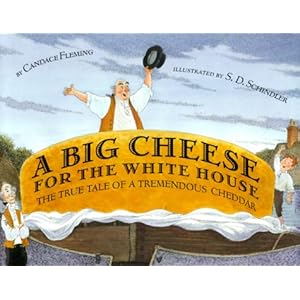
Summary
In A Big Cheese For The White House: A True Tale of Tremendous Cheddar citizens of Cheshire, Massachusetts get word that the president, Thomas Jefferson, is serving the cheese in the White House made by another New England town. Cheshire citizens band together to create a giant wheel of cheese to give to the president. They are successful in their task and are able to secure a place in the White House for Cheshire cheese during Jefferson’s presidency and beyond.
Impressions
As a cheese lover, the title of this book alone captivated my interest. Joking aside, I thought this book was a wonderful illustration of a quirky moment in history and of how cheese is traditionally made. I think this story would be an excellent addition to a founding fathers social studies unit. I was very impressed with the illustrations and layout of this book. Each page contains a great amount of detail which is helpful considering the historic time period. The illustrations in this book can help students visually understand the time period. Even with detailed illustrations, each page contains a nice amount of white space making the book easy to read. I also liked that the text is ample content wise and large visually.
Review: Horn Book Magazine
Sometimes, as this lively picture bock proves, truth is stranger than fiction. At the time of Jefferson's presidency, the folks in Cheshire, Massachusetts, home of the best cheese in the United States, "heard news that threatened to sour their curds forever." Several Cheshire citizens reported that the townsfolk of Norton, Connecticut, were not only coloring their cheddar and flavoring it as well, they were also the favored suppliers to the nation's premier dwelling — the White House. Such an exigency demanded drastic action. Elder John Leland proposed a solution: a concerted effort to make a huge cheddar as a gift for President Jefferson — a cheese so large that he would serve it for years, thus eliminating the competition. Except for the dissenting voice of Phineas Dobbs, a curmudgeon if ever there was one, the citizens of Cheshire embarked on their historic project. How they solved problems from finding a cheese press large enough to squeeze the whey to transporting the huge object to Washington is a triumph of Yankee ingenuity documented in a reportorial, tongue-in-cheek style, extended in droll, elegantly limned pen, ink, and watercolor illustrations. The book is handsome — as pleasing to look at as it is delightful to read.
Suggested Activities
I would include this book in a storytime. Activities would include a snack time where participants can try different types of cheese and cheese flavored snacks.
Bibliography
Fleming, C. (1999) A Big Cheese for the White House: The True Tale of a Tremendous Cheddar. New York: DK Pub. ISBN: 0789425734.
Burns, M.M. (1999, September) [A review for the book A Big Cheese for the White House: The True Tale of a Tremendous Cheddar by Candace Fleming]. Horn Book Magazine, 75(5), 594-595.





